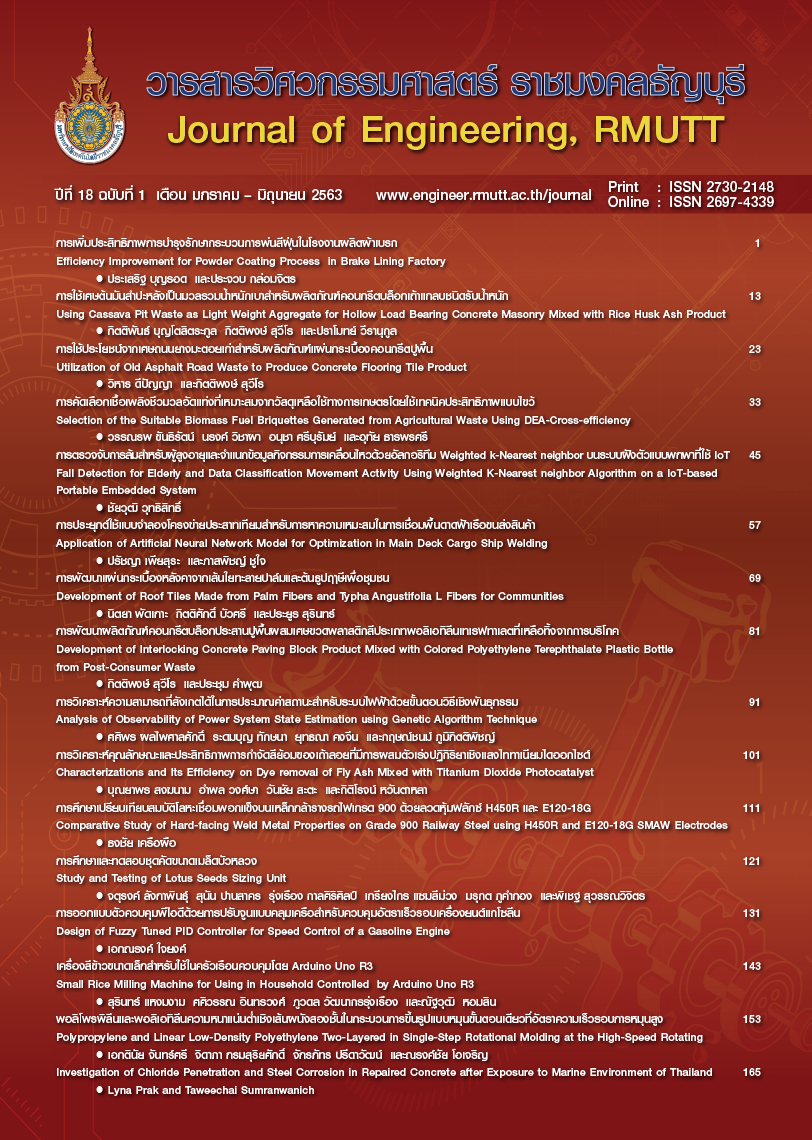Investigation of Chloride Penetration and Steel Corrosion in Repaired Concrete after Exposure to Marine Environment of Thailand
Main Article Content
Abstract
This paper aims to investigate the chloride penetration and the steel corrosion in the repaired concrete specimen after exposure to the marine environment of Thailand. The repaired concrete specimen was made in the laboratory and then exposed to the tidal zone of the marine site. There were two parts in the repaired concrete specimen, which were original concrete (OC) and replaced concrete (RC). Cement-only concrete and fly-ash concrete with water to binder ratio (w/b) of 0.65 were used for making the OC, while the RC was produced from fly-ash concrete with w/b of 0.55. The binder replacement by fly ash was employed at 30% and 50%. From the experimental results, it was found that types of concrete in the OC and RC significantly affected the chloride penetration and steel corrosion in the repaired concrete specimen. Chloride penetration resistance of the repaired concrete specimen that the RC made from fly-ash concrete with 50% of FA was higher than that from fly-ash concrete with 30% of FA, while the steel corrosion level was also lower. In addition, the availability of the initial chloride in the OC influenced the chloride penetration profile and steel corrosion level in the RC.
Article Details

This work is licensed under a Creative Commons Attribution-NonCommercial-NoDerivatives 4.0 International License.
The manuscript, information, content, picture and so forth which were published on Frontiers in engineering innovation research has been a copyright of this journal only. There is not allow anyone or any organize to duplicate all content or some document for unethical publication.
References
Zhang MH,Gjorv OE. Effect of silica fume on pore structure and chloride diffusivity of low porosity cement pastes.Cement and Concrete Research. 1991;21(6):1006-14.
Chen SC, Huang R, Hsu HM, Zou SY,Teng LW.Evaluation of penetration depth and protective effectiveness of concrete-penetrating sealer materials.Journal of Marine Science and Technology.2016; 24(2):244-9.
Prak L,Sumranwanich T,Tangtermsirikul S. A study on chloride profiles of concrete repaired with fly ash concrete and crystalline material.The 7thInternational Conference of Asian Concrete Federation,“Sustainable Concrete for Now and the Future”, 30 Oct –02 Nov, 2016, Hanoi, Vietnam, www.acf2016.vn
Pérez BM, Zibara H, Hooton RD,Thomas MDA. A study of the effect of chloride binding on service life predictions. Cement and Concrete Research. 2000;30:1215–23.
Florea MVA,Brouwers HJH. Modelling of chloride binding related to hydration products in slag-blended cements.Construction and Building Materials. 2014;64:421–30.
Arttamart S, Sumranwanich T.Compressive strength and chloride penetrationresistance ofconcrete withfly ash,limestone powder and partialreplacementof fine aggregate by bottom ash. Journal of Engineering, RMUTT. 2019;2(2):113-25.
Oh BH, Kim KH, Jang BS. Critical corrosion amount to cause cracking of reinforced concrete structures. Materials Journal. 2009; 106(4): 333-9.
Boddy A, Brntz E, Thomas MDA, Hooton RD. An overview and sensitivity study of a multimechanistic chloride transport model. Cem. Con.1999; 29(6): 827–37.
De Weerdt K, Colombo A, Coppola L, Justnes H, Geiker MR. Impact of theassociated cation on chloride binding of Portland cement paste. Cem. Con.2015; 68:196–202.
American Society for Testing and Materials. ASTM C1152.Standard test method for acid-soluble chloride in mortar and concrete.Annual Book of ASTMStandards.2003; Vol. 4.04
American Society for Testing and Materials. ASTM G1, Standard Practice for Preparing, Cleaning, and Evaluation Corrosion Test Specimens. Annual Book of ASTMStandards.2003;Vol.03.02.


